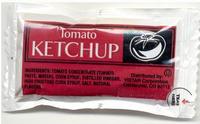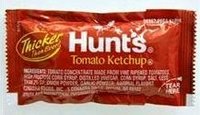Ketchup Diver
click for pipette diver Materials:
|
 |
|---|
| Step 1: Go to your favorite fast food restaurant and pick up several condiment packets such as ketchup. Not every packet will work because the volume of air in the condiments is slightly different. Therefore pick up several at a time. |  |
| Step 2: Place a condiment packet from a fast food restaurant into a tub full of water. The condiment packet should just float on the surface. If it floats too high, or sinks, try another packet until you have one that just floats. |  |
| Step 3: Place the condiment packet in the 2-liter bottle filled to the top with water and screw on the bottle top very tightly. | |
| Step 4: Squeezing the 2–liter bottle increases the pressure which compresses the volume of trapped air in the condiment package, causing it to sink. Pressure is released when you stop squeezing the 2-liter bottle, causing the volume of trapped air to increase and the packet to float. |  |
Discussion:
This is a very simple and inexpensive way to demonstrate the principle of pressure and density. The Cartesian diver is a very old experiment named after the 17th century French philosopher and mathematician, Rene Descartes. All objects either sink or float based on buoyancy. Buoyancy depends on an object’s density. An object more dense than the containing liquid (the water) sinks; an object less dense than the liquid floats. Density is defined by the equation D = m/v, where D is the object's density, m is the object's total mass and v is the volume of the object. The Cartesian diver demonstrates the density relationship of water and air. In this experiment you will be changing the density of the diver by changing the volume of air inside the ketchup package. The volume of a gas decreases as the pressure on the gas increases. Squeezing the 2–liter bottle increases the pressure in the system, which decreases the volume of the trapped air inside the packet. The volume of air in the packet gets smaller, so the total volume of the packet decrease, which increases the density of the packet (the diver), which, now heavier and less buoyant, sinks to the bottom. Pressure is released when you stop squeezing the 2-liter bottle causing the volume of air to expand in the packet, increasing the volume of the packet, and the density of the overall packet decreases. This in turn causes the diver to increase in buoyancy and rise.
Student Questions and Teacher Answers for those that want to "dive deeper":
Q1. Why do some objects float in water and some objects sink?
A1. An object floats in a fluid (be it a liquid or a gas) if the object is less dense than that fluid. The object sinks if it is denser than the fluid
Q2. What is density?
A2. Density is the ratio of a substance's mass to its volume. It can be considered an indication of how tightly concentrated the matter is in a given substance.
Q3. Describe two ways the density of an object can be increased?
A3. Since density is a ratio or fraction, it can be increased by increasing the numerator (the mass) while holding the denominator (the volume) constant. It can also be increased by holding the numerator (mass) constant while decreasing the denominator (volume).
Q4. What is pressure?
A4. Pressure is defined as the force exerted on a surface per unit area. Gas samples tend to exert pressure on a surface by the action of their particles colliding with that surface.
Q5. Describe the relationship between pressure and volume for a gas sample?
A5. Pressure and volume vary inversely for a gas sample. As the pressure of a gas sample increases, the sample's volume decreases proportionately, and vise-versa.
Q6. How are solids and liquids different than gases in terms of volume changes?
A6. In solids and liquids, the particles are so close together that the volume of a sample is due almost entirely to the volume of the particles themselves, not the space between them. Since compressing the volume of the particles requires very high pressures, solids and liquids are generally considered incompressible. In gases, however, the particles are so far apart that the volume of a sample is due almost entirely to the empty space between the particles, and not to the volume of the particles themselves. Increasing pressure has a profound influence on the volume of a gas sample, for it pushes the particles closer together; thus gases are considered compressible.
Q7. What caused the diver to dive when the bottle was squeezed?
A7. Consider answer A6 above. Since liquids are not compressible and gases are, as the bottle was squeezed, the pressure is transferred through the water and compresses the air pocket inside. As more water is pushed in through the mouth of the diver, the density increases. When the density of the diver surpasses that of the water, the diver dives to the bottom.
Q8. Describe the differences between the open and closed divers.
A8. The closed diver actually changes shape and collapses as pressure increases. The volume of the diver decreases significantly. The open diver volume remains the same, but it fills with water as the air volume decreases in response to the increase in pressure.
Q9. Explain how submarines can dive and surface using the principles observed in your divers.
A9. Pumps compress air and allow water into special tanks to submerge the submarines. To surface, the submarines allow the air to expand back to its original volume and expel the water.
Some References:
http://littleshop.physics.colostate.edu/onlineexperiments/Cart.html
http://dwb.unl.edu/chemistry/beckerdemos/BD031.html
http://www.ccmr.cornell.edu/education/modules/documents/CartesianDiver.pdf
http://www.sandia.gov/ciim/FSN/experiments/cartesian-divers.DOC
Written by Linda Bennett and Tracey Mitchell of the Chicago Section, American Chemical Society

